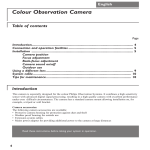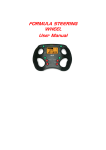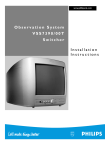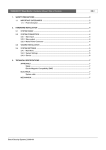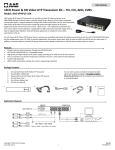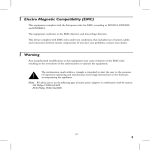Download Philips CCD User's Manual
Transcript
Technical specification CCD CAMERA 10 Pick-up device No. of picture elements (H) x (V) CL 46610005/13G 3 2 4 12 • • • 13 CL 76610012_002.AI 100697 CL 76610012_001.AI 00697 15 14 • 100m • 200m 0X1 • • 0-50m 300m Built-in microphone Lens type Lens viewing angle focal length relative aperture focus range Power supply Power consumption System cable Tripod socket Dimensions (WxHxD) Weight Ambient conditions Ambient temperature operating storage Ambient humidity operating storage 512 x 492 (EIA) 512 x 582 (CCIR) > 380 TVL 0.5 ~ 30000 lux 400 ~ 1000 nm > 48 dB RJ 11 E modular 'telephone' socket electret integrated 59°H x 46°V 4 mm F 2.0 1~∞m 16 ~ 27 VDC (via system cable) 50 mA (at 24 VDC) 4-wire dual twisted pair 'telephone' cable 1/4" B.S.W. 70 x 70 x 79 mm (incl. lens) 205 gr Ammonia resistant +10 ~ +55°C -25 ~ +70°C > NEAR 5 1 R< FA 1 Horizontal resolution Light sensitivity Spectral sensitivity range Signal to noise ratio Output A/V 1/3" (Solid state CCD) CL 76610011_004.AI 2 34 5 20% ~ 90%RH 99%RH 3 45 4-5 0X1 Specifications may be changed without notice. CL 76610012_003.AI Figure B 53 45 2-3 2-3 Figure A 3 4-5 2 34 5 2 2 Electro Magnetic Compatibility (EMC) This equipment complies with European rules for EMC according to EN55013, EN55020 and EN50082-1. 1 2 Operation is subject to the following two conditions: This device may not cause harmful interference. This device must accept any interference received, including interference that may cause undesired operation. The equipment conforms with the EMC directive and low-voltage directive. This device complies to FCC rules under test conditions that included use of system cables and connectors between system components. If you have any problems, contact your dealer. Warnings Any unauthorized modification to this equipment may cause violation of the FCC rules resulting in the revocation of the authorization to operate the equipment. To prevent fire or shock hazard, do not expose this accessory to rain or moisture. Do not attempt to disassemble the camera. In order to prevent shock and fire hazard, do not remove screws or covers. There are no user-serviceable parts inside. g The exclamation mark within a triangle is intended to alert the user to the presence of important operating and maintenance (servicing) instructions in the literature accompanying the appliance. g 1 English Observation Camera Introduction Your new CCD camera is developed for use with a special observation system monitor. It features a sensitive microphone thus registering both images and sound via the monitor, as well as input contacts for connecting external alarm devices. Installation Warning: " Disconnect the monitor from the mains supply before disconnecting a camera or accessory. Only operating the stand-by key is not sufficient. When the mains supply is connected, all camera lines are scanned. The monitor uses this to register the camera configuration of the system and to check whether any modifications have been made. Sound If required, the microphone incorporated in the camera, can be switched off (fig. A-14). If an intercom box is included in the camera line, the sound of camera and intercom box will be reproduced by the monitor. English The illustrations to which this manual refers, are shown on the front and back jacket flap. g 2 Alarm inputs The camera has a three-pole terminal block (fig. A-13) for connecting alarm sensors, such as doorcontacts. For normally open (N.O.) sensors, connect to contacts N.O.. For normally closed (N.C.) sensors, connect to contacts N.C.. Position • • • • • • • First you need to determine where the camera is to be installed. The best results are obtained when the camera looks a little downwards and not into a bright source of light. Hold the camera in your hand at the spot where you want to install it and check on the monitor whether the camera does actually cover the required area from that spot. Fasten the mounting bracket to the ceiling, the wall, or another even and firm surface by means of the supplied screws and plugs. Tighten the knob (fig. A-3) of the ball-and-socket joint. Fasten the camera to the bracket by screwing the mounting hole in the back or bottom of the camera (fig. A-1) onto the threaded end (fig. A-2). Loosen the knob of the ball-and-socket joint (fig. A-3) and, if necessary, the screw (fig. A-4) on the mounting bracket and direct the camera accurately at the object or area you want to have on screen. The knob and screw can be tightened again when the camera is in the required position. Remark: The camera can also be mounted on any other camera tripod standardly provided with a 1/4" 20 UNC thread. Check if the cable length compensation (fig. A-15) selector is set to the correct length. The length set must be the same as the length of the system cable (0-300m/900ft max.) connecting monitor and camera. Focus adjustment Adjust the focus ring (fig. B-1) of the camera lens to obtain an optimal image sharpness. g 3 Protective cover For outdoor use a protective cover (fig. A-10) (optional) has to be used to protect the camera from rain and snow. System connection Connect the system cable to the output of the camera (fig. A-12). The lens Caution: Do not touch the glass of the lens. This could damage the delicate coating on its surface. If the lens has to be cleaned, use a special lens cleaning tissue, available at any good camera store. Focus range The built-in lens provides an optimal image sharpness for objects between 1 metre and infinity (depth of field). Cable A 4-wire system cable (see specifications) is supplied standardly. For an optimum picture and sound quality a standard dual 'twisted-pair' (telephone) cable should be used. There is an extensive range of plugs and tools available in the hobby and professional trade to extend the cable. Always pay attention that the connection corresponds to figure B. Caution: The plugs used for the observation system have the same dimensions as standard telephone plugs. Never connect a telephone to the camera or system monitor. The maximum distance that can be bridged (without a cable extension adapter) between the monitor and the cameras is 300 meters. g 4 Tips for maintenance Cleaning The outside of the camera can be cleaned with a moist fluff-free cloth or a shammy leather cloth. When cleaning the objective a special lens cleaning cloth should be used. Do NOT use cleaning fluids based on alcohol, methylated spirit, ammonia, etc.. Avoid direct contact with water. g 5







